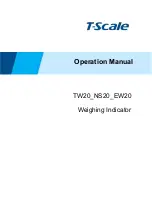
15 |
P a g e
5.1.7.1
Sensor Trigger Function
The Sensor Trigger function is used to reset the IPSO min/max values as well as control the Calibration process
.
Sensor Trigger Function
7
6
5
4
3
2
1
0
0
0
0
0
0
0
0
Reset
Min/Max
15
14
13
12
11
10
9
8
0
0
Calibration
Reset
Calibration
Status
Calibration
Mode
Capture
High
Capture
Low
Calibration
Start
The Calibration mode is entered by writing a 1 to the Calibration Mode bit. While in the calibration mode the
calibration registers may be accessed, the Capture High/Low may be used to capture real time values and the
Calibration Start may be set.
When the Calibration Start bit is set the Calibration Status bit will remain set until the calibration process is complete.
Setting the Calibration Reset bit will clear the calculated Gain, Offset and Tare values.
5.2
Digital Input / Output Interface
The DIO Interface provides 2 digital inputs which are hardwired to the Digital outputs. These may be used to detect the
state of external switches (output off) or to monitor the state of the outputs. The DIO Input descriptor is at base addresses
0x0068.
5.2.1
DIO Descriptor
Offset
Name
Value
Description
0x00
Sensor Type
0x18
Digital Type (Bit mapped)
0x01
Data Type/Format
0x46
Configurable, Float type
0x02
Configuration
0x23
Scaling applied, Bits 0 and 1 enabled
0x03
Sensor Device
0x0f
DIN bits enabled / inverted
0x04..0x08
UOMR
“DIN”
Units of measure
5.2.1.1
DIO Sensor Type
The interface provides a bit mapped input of the 2 digital signal lines.
Sensor Type
SI Derived Units
Measurement
0x18
DIN
Bit mapped digital inputs
5.2.1.2
DIO Data Type/Format
DIO Data Type
7
6
5
4
3
2
1
0
Smart Sensor
Sensor Writable
Factory Calibrate
reserved
Data Type
0
0
0
0
6 == Floating point
Note:
Please refer to the Smart Sensor Interface Technical Guide for more information regarding this descriptor.
5.2.1.3
Data Type
The 4-bit Data Type field determines the type of date of the specific sensor.
5.2.1.4
Factory Calibrate
The Factory Calibrate bit is not used for DIO types.







































